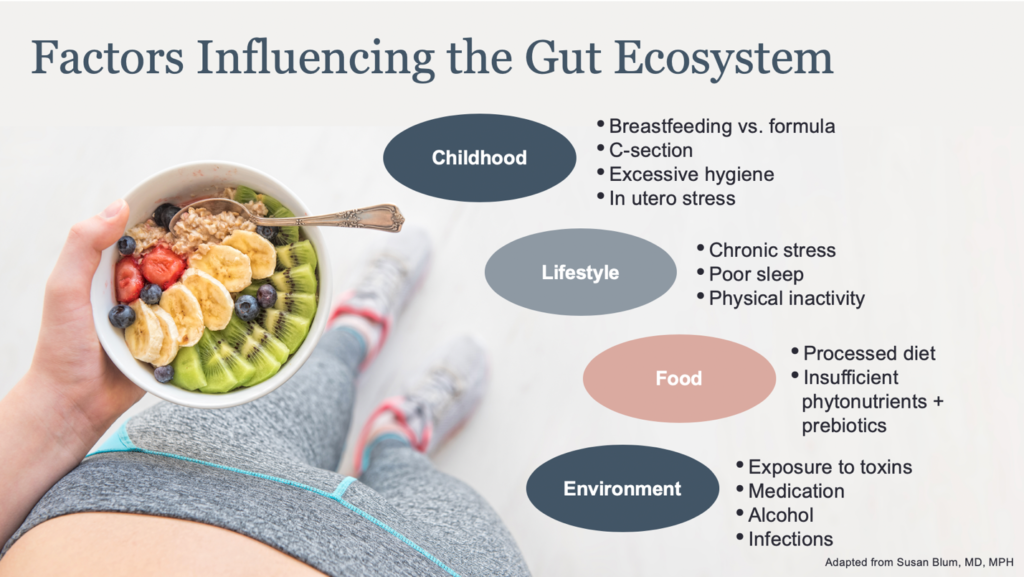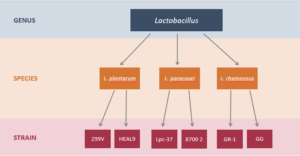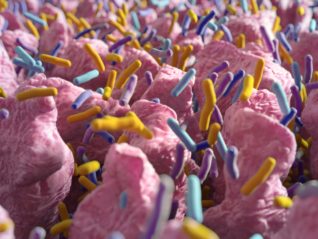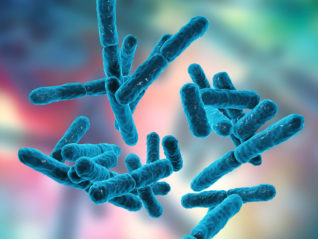
by Sara Gottfried, MD and Noelle Patno, PhD
| As our understanding of the gut microbiome expands, many questions remain about the clinical relevance—particularly how emerging concepts translate into the front lines of patient care, including best practices for probiotics. What is a probiotic? Why use one, and what are the most well-substantiated clinical situations in which they affect patient outcomes? What is the mechanism of action for probiotics? How do we know probiotics “work” in our patients? How can I be sure of claims on the label of the probiotics that I prescribe? Frequently, products on the market labelled as “probiotics” lack obvious links to the clinical evidence that would support the usage indication, nor do the products consistently offer marks of a quality-controlled, well-characterized, stabilized set of live microorganisms typical of real probiotics. The aim of this article is to provide an overview of the data that support or refute the role that probiotics may have in influencing health and science-based recommendations for the use of probiotics as therapy for common health conditions. |
Probiotics are live microorganisms that, at the right dose, deliver clinical benefits that include relieving gastrointestinal distress, supporting the immune response, managing weight and cardiometabolic effects and may even confer health benefits to the brain. They have been used in the form of yogurt, other fermented foods, and even human fecal matter from hundreds to thousands of years ago to treat or prevent various intestinal diseases. In the historical battle we have taken with overuse of antibiotics in our environment as well as in the intestinal environment, we need more clinical strategies to support the growth of beneficial bacteria including key species associated with health as well as to maintain a strong intestinal barrier for the gastrointestinal (GI) system to perform its main roles of digestion and defense. Now, with more advanced technology to understand the intestinal microbiome, we have a greater understanding of the ways in which many lifestyle influences, particularly diet, affect the diversity of the microbiome and dysbiosis associated with disease.
The bacteria in the intestine interact with the intestinal cells and the nearby immune cells in a variety of mechanisms to inhibit pathogen growth and strengthen the intestinal barrier as well as provide key metabolites for promoting a healthy intestinal environment. Probiotics are those specifically-identified strains of bacteria which provide clinical benefits when supplemented at the right dose. Supplementing the bacteria in the intestine with probiotics has been shown to be efficacious in a variety of outcomes including irritable bowel syndrome (IBS), inflammatory bowel disease (IBD), antibiotic-associated diarrhea, preventing upper respiratory tract infections, and immune response. Emerging evidence shows some benefit in cases of small intestinal bacterial overgrowth (SIBO), liver disease, skin health, oral health, cardiometabolic and brain health. Probiotics are a powerful intervention for clinicians to use to treat patients by starting from the gut to support not only gastrointestinal and immune health but extraintestinal symptoms as well – from the gut to the liver, the gut to the heart, the gut to the lung, the gut to the skin and the gut to the brain.
Historical evidence of the benefits of probiotics
Over a hundred years ago, Nobel-winning scientist Elie Metchnikoff discovered that probiotics found in yogurt benefited health. He introduced the theory that consuming probiotics would prevent growth of pathogenic bacteria in the lower intestine.1 Known as the “father of innate immunity,”2 Metchnikoff performed his award-winning research on phagocytosis (immune cells consuming bacteria as a defense mechanism). Content with his own self-experimentation with yogurt, he hypothesized the benefits of probiotics for general use and promoted the use of probiotics in the form of yogurt (Lactobacillus bulgaricus).1
However, even prior to that, the use of good bacteria to address severe diarrhea or food poisoning occurred via the transfer of human fecal matter, the first fecal microbial transplant (FMT), in China in the 4th century.3 Treating digestive and immune health by promoting a healthy environment in the intestine through diet as well as the internal matter itself has been a practice around for a long time. As the study of bacteria and the immune system expanded with key figures including Koch, Ehrlich and Mechnikov and Fleming, we began to understand bacteria more as instigators of infection and have since established a long history of antibiotic use.3
Widespread use of antibiotics began in the 1940s, and we learned within decades that we are potentially killing microbes indiscriminately and putting ourselves at risk. In the 1990s, Abigail Salyers at the University of Illinois decried the overuse of antibiotics in the context of the increasing rise of antibiotic-resistance genes transferring among microorganisms within the human body, and declared our previous success against infectious diseases may be at risk.4 Her theory was supported by the research of Martin Blaser at New York University School of Medicine, and he went on to challenge persistent dogma with the publication in 2014 of his book Missing Microbes: How the Overuse of Antibiotics Is Fueling Our Modern Plagues.5 Even the New York Times review by Abigail Zuger MD reported that the “weight of evidence behind Dr. Blaser’s cautions about antibiotics is overwhelming.”6 This link between antibiotic overuse, the havoc wreaked on our intestinal microbiomes, and loss of good bacteria with the rise in autoimmune and psychiatric disease leads us to further research on the microbiome and probiotics. The observation that the major reduction in infections in early life combined with the rise in allergies led to the “hygiene hypothesis” – infections prevented allergies7 – which now leads us to the hypothesis that certain bacteria,7 potentially probiotics, may then prevent allergies. Missing contact with old friends” may be underlying the rise in not only allergies but also autoimmune and psychiatric disorders.8,9 Yet understanding the role of the bacteria and other microbes in our gut and broader health requires deeper research into the microbiome, probiotics and translation into actionable clinical guidelines.
Major research projects on the microbiome With the knowledge that we need a healthy intestinal environment, more advanced research has been done to identify associations between the microbiome (particularly the intestinal microbiome) and health. Our current understanding of the microbiome is derived from several key streams of evidence.
- Human Microbiome Project (HMP). Beginning in 2007,10 the National Institute of Health’s HMP provided over the past decade a more comprehensive characterization of the entire human microbiome and its role in health and disease began. HMP has provided an efficient and organized database system and analytical tools and technologies to cross-reference over 2,200 reference strains from 300 healthy adults at five major body sites: oral cavity, nasal cavity, skin, gastrointestinal tract, and urogenital tract.11
- Integrative Human Microbiome Project. The next phase of HMP is known as the Integrative Human Microbiome Project, designed to assess the host and microbiome under several conditions: pregnancy and preterm birth; inflammatory bowel disease; and stressors that affect people with prediabetes.12
- American Gut Project. Rob Knight, PhD, Founding Director of the Center for Microbiome and Research Professor of Pediatrics, Bioengineering, and Computer Science and Engineering at the University of California San Diego, launched this crowd-sourced research project in 2012. The American Gut Project provides the opportunity to elucidate geographic locations and dietary consumption as well as other factors connected to microbiome patterns.13
While the HMP repository, American Gut, and other independent research initiatives continue to document patterns in the intestinal microbiome, the scientific community still seeks to understand how the bacteria in our intestine affect health through investigation of in vitro work on specific bacteria, in vivo studies in animal models, and many clinical trials evaluating the impact of consuming bacteria.
Maintaining a healthy microbiome
Maintaining a healthy ecosystem in the intestine and a healthy homeostasis in the body requires maintaining an intact intestinal barrier as well as keeping the bacterial environment symbiotic. Many factors influence which bacteria reside in the intestine and their effects on health in the rest of the body, and nutritional therapies including probiotics may be used to address bacteria in the intestine as well as other aspects of health. In addition to a comprehensive intake of the patient, clinicians may consider the intestinal barrier and microbiome, particularly the following:
- Modifiable lifestyle factors that influence the intestinal microbiome (i.e., does the patient have an environment, sleep and exercise, as well as diet that supports the microbiome?)
- Dysbiosis (i.e., are blooms of pathogens present?)
- Diversity (i.e., does the patient have a diverse vegetable intake?)
- Intestinal permeability (i.e., allowing absorption of nutrients while preventing passage of bacteria and waste)
Research has suggested that there are many large influencers on the types of bacteria in our intestine and the different communities present.
- Maternal factors including the mother’s body mass index (BMI), pharmacotherapy during pregnancy, and the type of delivery influence the development of the infant’s intestinal microbiome before and during birth.14
- Factors associated with the development of the microbiome during early life include method of feeding, genetics, number of siblings, and birth location.15
- In adulthood, age, sex, BMI, respiratory infections, onset of chronic disease, diet, and environmental factors (e.g., exposure to cigarette smoke, air pollution, and allergens) affect the microbiome.16,17
- Multiple genetic and environmental and lifestyle factors and their interactions with one another may affect the intestinal microbiome and may result in dysbiosis.
Characterizations of the intestinal microbiome typically refer to 1) dysbiosis and 2) diversity.
Dysbiosis
Dysbiosis occurs when intestinal homeostasis is disrupted and can be categorized into one or more of the following:18
- Loss of beneficial organisms
- Excessive growth of potentially harmful organisms—not just bacterial species but yeast, parasites, and other
- Loss of overall microbial diversity
Well-known friendly microorganisms include Lactobacillus and Bifidobacterium. Beneficial microorganisms include key species such as Akkermansia muciniphila (associated with microbiomes of lean individuals and healthy metabolism)19 and Faecalibacterium prausnitzii (some evidence shows that it is reduced in inflammatory bowel disease20 and is reduced with age21) that appear to be higher in healthy individuals relative to those with diseases. Previously it was thought that the Firmicutes:Bacteroidetes ratio was an indicator of healthy versus diseased individuals; however, conflicting results across studies suggest that this ratio is not necessarily an indicator of health, and it is further complicated by the fact that methodological differences can affect this ratio.22
Diversity
Diversity in the intestinal microbiota refers to the types and abundances of various bacteria present.23 It is typically observed that more diverse intestinal microbiomes are associated with healthy individuals while less diverse ones are observed in diseased people.24–26 Diversity is a relative measurement and there is not currently an absolute standard of diversity to measure as a clinically meaningful outcome. Diet plays a major role in the types and abundances of bacteria in the gut,27,28 as different bacteria will be affected in different ways by various substrates. For example, the American Gut project has identified that consumption of more than 30 different types of plants per week was associated with a higher diversity of the gut microbiome than the diversity from samples of individuals who ate fewer than 10 different plant sources each week.13 Thus, dietary consumption, which may include prebiotics and probiotics, may affect health and disease through the microbiome in the intestine.
Intestinal Permeability
The two main roles of the gastrointestinal system, 1) to digest and 2) to defend, require a semi-permeable barrier. There are multiple types of cells in the barrier which have various functions such as producing mucus or secreting antimicrobial peptides (AMPs) and secretory IgA in addition to multiple immune cells that may interact with the bacteria and any foreign substances in the intestine.29 Definitions of relevance summarized below: 30
The intestinal barrier separates the gut lumen from the host consisting of its mucus, epithelial layer, defensins and IgA as well as the lymphocytes and innate immune cells, the muscular layer and the enteric nervous system.
Intestinal permeability is the function of the intestinal barrier which can be measured by molecular flux across the intestinal wall.
Normal intestinal permeability is stable flux in healthy people who do not have inflammation or toxicity or gastrointestinal malfunction while impaired intestinal permeability is a loss of the barrier function resulting in disturbed intestinal activity and disease.
Increased intestinal permeability is a sign of a dysfunctional intestinal barrier associated with intestinal diseases including IBS, IBD, celiac disease (CD), SIBO as well as extra-intestinal disorders. This “leaky-gut syndrome” has been associated with diseases such as rheumatoid arthritis, type I diabetes.31 In particular, a common problem is SIBO, which is characterized by nonspecific symptoms of varying length, intensity and occurrence that include flatulence, diarrhea, distension, belching, bloating, indigestion, and abdominal pain. 32
Prebiotics
While this article is about probiotics, we all know that prebiotics are essential to modulate the microbiome. Major components of the diet serve as prebiotics, which are substrates that are selectively utilized by host microorganisms conferring a health benefit.33 These include oligosaccharides including the popular inulin and fructooligosaccharides commonly from chicory root, readily fermentable dietary fibers or resistant starch, human milk oligosaccharides such as 2’-fucosyllactose, phenolics and phytochemicals, and certain types of fats.33 Prebiotics have been shown to improve metabolism (e.g., blood sugar control, cholesterol lowering), immune modulation, modification of cancer risk, and gastrointestinal function (e.g., improved gut transit times and gut barrier).34,35
Definition of a true probiotic
In 2013, the International Scientific Association for Probiotics and Prebiotics (ISAPP) updated the definition of probiotics to “live microorganisms that, when administered in adequate amounts, confer a health benefit on the host.”36 The World Health Organization (WHO) and Food Agriculture Organization (FAO) concur with this definition,37 and this consensus determines the need for 1) testing for viability, 2) ensuring appropriate dosage, and 3) providing clinical efficacy.37 Although many bacterial strains may be on the market or found in fermented foods and healthy intestinal environments, until these strains have been clinically studied and adequately characterized for health benefits at the sufficient amount, they do not fit the definition to be called “probiotics.”
Probiotics follow the conventional naming structure of bacteria that uses the phylogenetic system. Specific identification characterizes the type of bacteria by the larger category of genus, then the subcategory of species, and finally to the more detailed level of the strain. For example, Lactobacillus (genus) acidophilus (species) La-14 (strain) or NCFM (strain) would be two strains in the same Lactobacillus acidophilus group.
Identifying a true probiotic
In order to identify a bacterial strain as a probiotic, sourcing one from a healthy human intestine or from food such as dairy is a logical starting point since these bacteria already coexist safely with us and may be contributing to our health. There are many in vitro screening methods and animal models that can help investigate potential mechanisms of action to identify if the bacterial strains may exert therapeutic potential. Then these strains can be studied in clinical trials to determine dose and benefit and then be confirmed as a probiotic.
A few examples of mechanistic action by probiotics include the following:
- Survival in the intestinal tract
- Inhibiting pathogen growth
- Competitive exclusion by adhering to the intestinal cells, preventing pathogen attachment
- Producing metabolites such as lactic acid, bacteriocins, short-chain fatty acids (SCFA) that modify the intestinal environment including bacteria
- Enhancing epithelial barrier integrity
- Modulating immune cells which then may be able to fight off pathogens
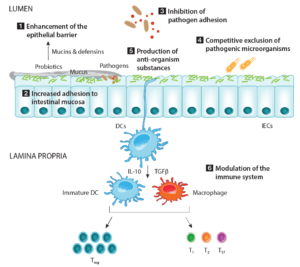
Besides the intestine, the vagina is also a potential source of probiotics for the promotion of a healthy vaginal microbial environment. Lactic acid production, predominantly by the genus Lactobacillus, provides an effective defense mechanism by lowering the pH, affecting the immune system, and defending against microbes and viruses in the vagina.38,39 Lactobacillus rhamnosus GR-1 and Lactobacillus reuteri RC-14 are examples of a couple of probiotics used for vaginal health.38 Examining soil and other sources may require more rigorous research to screen out pathogens by evaluating for pathogenic genes and pathogenic activity.
Is more better?
Maybe you learned during your training the misconception that “more is better,” or “multiple strains are more effective,” or certain types of bacteria dictate the quality or efficacy of the probiotic. A recent review concluded that no conclusion can be made about whether the single-strain or multiple-strain approach is more effective,40 likely because these have not been tested head-to-head in the same clinical trial as different experimental arms.
A few examples comparing different doses or strains are as follows:
1. A few dose-effect studies:
a. While both 17 billion CFU and 4.17 billion CFU of Lactobacillus acidophilus NCFM, Lactobacillus paracasei Lpc-37, Bifidobacterium lactis Bl-04, and Bifidobacterium lactis Bi-07decreased gastrointestinal symptoms in adult patients on antibiotics, the higher dose had a more significant effect.41
b. Whole-gut transit time improved significantly at both 1.8 billion CFU as well as at 17 billion CFU of Bifidobacterium lactis HN019; however, the high dose group’s effect was more significant (p<0.001 for high dose; and p=0.01 for the low dose). Of the nine gastrointestinal symptoms measured in the study, eight decreased for the high-dose group, which was one more than the seven that decreased in the low-dose group (only two decreased in the placebo group).42
c. Increasing the dose by 10-fold (from 5 to 50 billion CFU) of Bifidobacterium lactis HN019 resulted in similar immunomodulating effects: Both low and high dose in this study showed significant changes in immune cell responses. Specifically, there were increases in natural killer cells and activated T lymphocytes in the blood, and the ex vivo assays showed greater activity of these immune cells to fight tumors and phagocytose coli.43
2. Different strains tested in parallel: There have been few studies comparing different probiotics to each other and measuring clinical outcomes. One example is a pilot study in which participants were randomized to consume placebo or one of seven different probiotic strains, each at 20 billion CFU/day for 3 weeks. Participants were vaccinated with cholera on day 7 and day 14 during a 3-week period of consuming a probiotic strain, and serum was collected to measure specific IgA, IgG, and IgM, and saliva was collected for specific IgA measurement. There was an increase in serum IgG that was significant (p=0.01) compared with controls for the consumption of Bifidobacterium lactis Bl-04 or Lactobacillus acidophilus La-14. Not as significant (p=0.09), Lactobacillus plantarum Lp-115 and Bifidobacterium lactis Bi-07 also increased IgG. Probiotic usage in this situation would suggest enhancing the vaccination effort by increasing antibody levels to support the immune system’s protective response, in this case, against cholera.44
3. Single strain v. multiple strain. Not many studies have actually compared a single strain to multiple strains with the appropriate controls for variations in amounts. Here’s one example of a single strain at one amount and a combination of strains at another amount:
Clinical efficacy of probiotics—demonstrated health benefits in humans
A recent meta-analysis of clinical trials involving probiotics demonstrated that efficacy is specific both to the indication or condition and to the specific strain.41 Probiotics have been evaluated for usage and demonstrated efficacy in many conditions, including the following list of globally-recognized indications:45,46
- Irritable bowel syndrome (IBS)
- Inflammatory bowel disease (IBD) – pouchitis and ulcerative colitis
- Acute gastroenteritis
- Immune response
- Treatment of acute diarrhea
- Prevention of Clostridium difficile diarrhea
- Prevention of antibiotic-associated diarrhea
- Prevention of upper respiratory tract infections (common cold)
Additionally, probiotics are used for the health of lactobacilli-dominant vagina,39 and to support weight management.47More research is needed to provide evidence-based recommendations for probiotic applications in small intestinal bacterial overgrowth,48 cognitive health, cardiovascular health,49 liver and skin health, migraines50,51 as well as oral health.52
For specific details summarizing clinical efficacy of specific probiotics for particular indications, please refer to this third-party clinical guide (http://www.usprobioticguide.com/PBCIntroduction.html) and for a short summary, this probiotics science review.
Safety
While most probiotics in the United States are sold as dietary supplements, probiotics are not an independently regulated category, and manufacturers may choose to identify the purpose of a probiotic product to be a food, dietary supplement, or drug, which affects its regulation by the Food and Drug Administration (FDA).53 International organizations such as ISAPP and the FAO/WHO working group have established guidelines for characterization and safety of probiotics. These include a report of the Joint FAO/WHO working group on probiotics in food set forth with guidelines that probiotic strains be characterized at a minimum with a series of tests, including resistance to antibiotics, production of metabolites, production of toxins, hemolytic activity, side effects in humans, and adverse events postmarket.37 Screening the genomes for pathogenicity as well as antibiotic resistance genes provides a safety check for these microorganisms. The Council for Responsible Nutrition (CRN)/International Probiotic Association (IPA) guidelines also include best practices that specify labeling (colony-forming units, or CFU, indicating viability of the live microorganisms), stability testing, and storage recommendations.54
In general, probiotic consumption has been demonstrated to be safe (these are specific, characterized probiotics in clinical studies) and rarely result in complications.55 Epidemiological usage indicates no overall increase in adverse events. Two major safety concerns are the following:
- Side effects may occur, typically these are transient and commonly these include gas and bloating.
- Critically ill and severely immunocompromised individuals may be at risk for adverse events; avoid probiotic usage in these populations.
Quality control and stability studies are the responsibility of the manufacturer to ensure that contaminants (such as pathogenic bacteria, heavy metals, etc.) are not present, that the stated amount of living microorganisms of that particular strain(s) are present, and that the amount on the label extends to the end of shelf life at the recommended storage conditions.
Conclusions and resources
Probiotics have a long history of usage through food and are increasingly becoming better characterized and widespread in dietary supplements. While many factors from genetics to environment—particularly diet—influence the intestinal microbiome, the efficacy of probiotics has been demonstrated not for intestinal microbiome changes but for specific clinical outcomes such as relief of gastrointestinal distress, reduction in the incidence of colds, mitigation of bacterial vaginosis, and some evidence suggests that probiotics may even modify stress response or reducing migraines. By the international consensus of its definition, effective probiotics are live microorganisms that have been well-characterized and stable at the adequate amounts to confer health benefits. Probiotics with specific indications may help support general health and alleviate certain digestive, respiratory, and metabolic and urogenital symptoms.
Authorities such as ISAPP, CRN/IPA and WHO/FAO have established guidelines for probiotics, and organizations such as the World Gastroenterology Organization45 and AEProbio56 have published clinical guides to support physician recommendation of probiotics.
While continued research of probiotics and the human microbiome is necessary in healthy and diseased populations to investigate potential diagnostic and therapeutic solutions, probiotics are a smart clinical tool to promote patient health in a variety of conditions.
Citations
- Mackowiak PA. Recycling Metchnikoff: Probiotics, the intestinal microbiome and the quest for long life. Front Public Health. 2013;1.
- Gordon S. Phagocytosis: the legacy of Metchnikoff. Cell. 2016;166(5):1065-1068.
- Mohr KI. History of antibiotics research. In: Stadler M, Dersch P, eds. How to Overcome the Antibiotic Crisis. Vol 398. Cham: Springer International Publishing; 2016:237-272.
- Salyers AA et al. Resistance gene transfer in anaerobes: new insights, new problems. Clin Infect Dis. 1996;23(Supplement_1):S36-S43.
- Blaser MJ. Missing Microbes: How the Overuse of Antibiotics Is Fueling Our Modern Plagues. 1st ed. New York, NY: Henry Holt and Company, LLC; 2014.
- Zuger A, M.d. We Kill Germs at Our Peril. The New York Times. https://www.nytimes.com/2014/04/29/health/missing-microbes-how-antibiotics-can-do-harm.html. Published April 28, 2014. Accessed October 22, 2019.
- Ege MJ. The hygiene hypothesis in the age of the microbiome. Annals ATS. 2017;14(Supplement_5):S348-S353.
- Rook GAW et al. Microbiota, immunoregulatory old friends and psychiatric disorders. In: Lyte M, Cryan JF, eds. Microbial Endocrinology: The Microbiota-Gut-Brain Axis in Health and Disease. Advances in Experimental Medicine and Biology. New York, NY: Springer New York; 2014:319-356.
- Rook GAW et al. Microbial ‘old friends’, immunoregulation and stress resilience. Evol Med Public Health. 2013;2013(1):46-64.
- Turnbaugh PJ et al. The human microbiome project: exploring the microbial part of ourselves in a changing world. Nature. 2007;449(7164):804-810.
- NIH Human Microbiome Project – About the Human Microbiome. https://hmpdacc.org/hmp/overview/. Accessed July 11, 2019.
- The integrative HMP (iHMP) research network consortium. The integrative human microbiome project. Nature. 2019;569(7758):641-648.
- McDonald D et al. American gut: an open platform for citizen science microbiome research. mSystems. 2018;3(3).
- Mulligan CM et al. Maternal modifiers of the infant gut microbiota: metabolic consequences. J Endocrinol. 2017;235(1):R1-R12.
- Martin R et al. Early-life events, including mode of delivery and type of feeding, siblings and gender, shape the developing gut microbiota. PLoS One. 2016;11(6).
- Shukla SD et al. Microbiome effects on immunity, health and disease in the lung. Clin Transl Immunol. 2017;6(3):e133.
- Zhang YJ et al. Impacts of gut bacteria on human health and diseases. Int J Mol Sci. 2015;16(4):7493-7519.
- DeGruttola AK et al. Current understanding of dysbiosis in disease in human and animal models. Inflamm Bowel Dis. 2016;22(5):1137-1150.
- Dao MC et al. Akkermansia muciniphila and improved metabolic health during a dietary intervention in obesity: relationship with gut microbiome richness and ecology. Gut. 2016;65(3):426-436.
- Cao Y et al. Association between Faecalibacterium prausnitzii reduction and inflammatory bowel disease: a meta-analysis and systematic review of the literature. Gastroenterology research and practice.
- van Tongeren SP et al. Fecal microbiota composition and frailty. Appl Environ Microbiol. 2005;71(10):6438-6442.
- Vebø HC et al. Bead-beating artefacts in the Bacteroidetes to Firmicutes ratio of the human stool metagenome. J Microbiol Methods. 2016;129:78-80.
- Finotello F et al. Measuring the diversity of the human microbiota with targeted next-generation sequencing. Brief Bioinform.
- Manichanh C et al. Reduced diversity of faecal microbiota in Crohn’s disease revealed by a metagenomic approach. Gut. 2006;55(2):205-211.
- Mosca A et al. Gut microbiota diversity and human diseases: should we reintroduce key predators in our ecosystem? Front Microbiol. 2016;7.
- Lozupone CA et al. Diversity, stability and resilience of the human gut microbiota. Nature. 2012;489(7415):220-230.
- Singh RK et al. Influence of diet on the gut microbiome and implications for human health. J Transl Med. 2017;15:73.
- Mills S et al. Precision nutrition and the microbiome, part I: current state of the science. Nutrients. 2019;11(4).
- Vancamelbeke M et al. The intestinal barrier: a fundamental role in health and disease. Expert Rev Gastroenterol Hepatol. 2017;11(9):821-834.
- Bischoff SC et al. Intestinal permeability – a new target for disease prevention and therapy. BMC Gastroenterol. 2014;14.
- Graziani C et al. Intestinal permeability in physiological and pathological conditions: major determinants and assessment modalities. :16.
- Rao SS et al. Small intestinal bacterial overgrowth: clinical features and therapeutic management. Clin Transl Gastroenterol. 2019.
- Gibson GR et al. Expert consensus document: The International Scientific Association for Probiotics and Prebiotics (ISAPP) consensus statement on the definition and scope of prebiotics. Nat Rev Gastroenterol Hepatol. 2017;14:491.
- Holscher HD. Dietary fiber and prebiotics and the gastrointestinal microbiota. Gut Microbes. 2017;8(2):172-184.
- Roberfroid M et al. Prebiotic effects: metabolic and health benefits. Br J Nutr. 2010;104(S2):S1-S63.
- Hill C et al. Expert consensus document: The International Scientific Association for Probiotics and Prebiotics consensus statement on the scope and appropriate use of the term probiotic. Nat Rev Gastroenterol Hepatol. 2014;11(8):506-514.
- FAO/WHO. Guidelines for the Evaluation of Probiotics in Food. https://www.who.int/foodsafety/fs_management/en/probiotic_guidelines.pdf. Accessed July 11, 2019.
- Tachedjian G et al. The role of lactic acid production by probiotic Lactobacillus species in vaginal health. Res Microbiol. 2017;168(9-10):782-792.
- Reid G. The development of probiotics for women’s health. Can J Microbiol. 2017;63(4):269-277.
- Korada SK et al. Single probiotic versus multiple probiotics – a debate on current scenario for alleviating health benefits. CPD. 2019;24(35):4150-4153.
- Ouwehand AC et al. Probiotics reduce symptoms of antibiotic use in a hospital setting: a randomized dose response study. Vaccine. 2014;32(4):458-463.
- Waller PA et al. Dose-response effect of Bifidobacterium lactis HN019 on whole gut transit time and functional gastrointestinal symptoms in adults. Scand J Gastroenterol. 2011;46(9):1057-1064.
- Gill HS et al. Enhancement of immunity in the elderly by dietary supplementation with the probiotic Bifidobacterium lactis HN019. Am J Clin Nutr. 2001;74(6):833-839.
- Paineau D et al. Effects of seven potential probiotic strains on specific immune responses in healthy adults: a double-blind, randomized, controlled trial. FEMS Immunol Med Mic. 2008;53(1):107-113.
- WGO. World Gastroenterology Organisation Global Guidelines: Probiotics and prebiotics. 2017.
- Cruchet S et al. The use of probiotics in pediatric gastroenterology: a review of the literature and recommendations by Latin-American experts. Paediatr Drugs. 2015;17(3):199-216.
- Stenman LK et al. Probiotic with or without fiber controls body fat mass, associated with serum zonulin, in overweight and obese adults—randomized controlled trial. EBioMedicine. 2016;13:190-200.
- Zhong C et al. Probiotics for preventing and treating small intestinal bacterial overgrowth: a meta-analysis and systematic review of current evidence. J Clin Gastroenterol. 2017;51(4):300-311.
- Vasquez EC et al. Probiotics as beneficial dietary supplements to prevent and treat cardiovascular diseases: uncovering their impact on oxidative stress. Oxid Med Cell Long. 2019;2019:1-11.
- de Roos NM et al. The effects of the multispecies probiotic mixture Ecologic®Barrier on migraine: results of an open-label pilot study. Benef Microbes. 2015;6(5):641-646.
- Dai YJ et al. Potential beneficial effects of probiotics on human migraine headache: a literature review. Pain Physician.:6.
- Rondanelli M et al. Using probiotics in clinical practice: where are we now? A review of existing meta-analyses. Gut Microbes. 2017;8(6):521-543.
- Research C for BE and Complementary and Alternative Medicine Products and their Regulation by the Food and Drug Administration. U.S. Food and Drug Administration. http://www.fda.gov/regulatory-information/search-fda-guidance-documents/complementary-and-alternative-medicine-products-and-their-regulation-food-and-drug-administration. Published October 17, 2019. Accessed October 23, 2019.
- CRN-IPA-Best-Practices-Guidelines-for-Probiotics.pdf. https://www.crnusa.org/sites/default/files/pdfs/CRN-IPA-Best-Practices-Guidelines-for-Probiotics.pdf. Accessed July 11, 2019.
- Borriello SP et al. Safety of probiotics that contain Lactobacilli or Bifidobacteria. Clin Infect Dis. 2003;36(6):775-780.
- Probiotic Chart. http://www.usprobioticguide.com/PBCIntroduction.html?utm_source=intro_pg&utm_medium=civ&utm_campaign=USA_CHART. Accessed July 11, 2019.
Sara Gottfried, MD is a board-certified gynecologist and physician scientist. She graduated from Harvard Medical School and the Massachusetts Institute of Technology and completed residency at the University of California at San Francisco. Over the past two decades, Dr. Gottfried has seen more than 25,000 patients and specializes in identifying the underlying cause of her patients’ conditions to achieve true and lasting health transformations, not just symptom management.
Dr. Gottfried is a global keynote speaker who practices evidence-based integrative, precision, and Functional Medicine. She recently published a new book, Brain Body Diet and has also authored three New York Times bestselling books: The Hormone Cure, The Hormone Reset Diet, and Younger.
Noelle Patno, PhD received her PhD in Molecular Metabolism and Nutrition and Masters in Translational Science from the University of Chicago, studying the role of microbial components in intestinal epithelial cell survival related to inflammatory bowel disease. Prior to her graduate studies, Dr. Patno received a chemical engineering degree from Stanford University and worked as an engineer. She has personal experience and interest in preventive nutrition and nutritional therapies for chronic disease, and her current role involves researching and developing probiotics, prebiotics, and other nutritional programs for the promotion of digestive and overall health.

